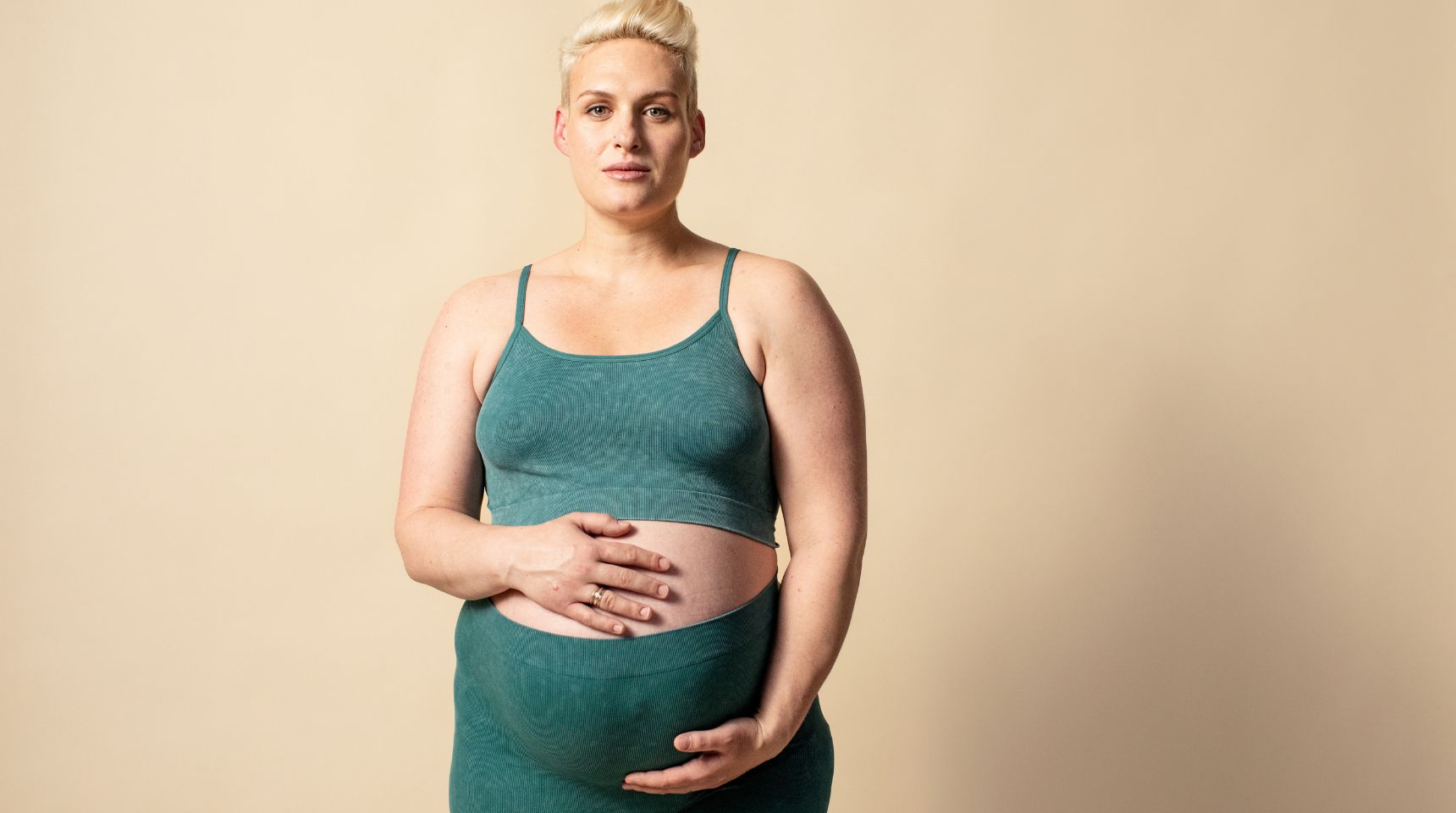Four babies call Tiffany mom. Well, they’re not all babies anymore! Her oldest is 15 and learning to drive, and her youngest is 2 months and a champion at nursing. Tiffany’s breastfeeding experience has progressed with each child, leading to great advice and perspective, and an invention that (literally!) supports thousands of breastfeeding moms.
What she told us:
“My friends joke that I had a fourth baby just so I could breastfeed again – because I just love it when you get to lay down with them and just relax. You both kind of exhale and calm down and it's just y'all. Just talking about it makes me want to cry. It makes me so happy. It’s love. It’s the two of you and nobody else can do that. It's just you. It's such a special bond.”
Tiffany’s story:
Tiffany’s breastfeeding story has evolved along with her journey as a mom, She was 23 and she didn’t have a lot of information about breastfeeding. She remembers still being very uncomfortable with her own body, which made the first time she breastfed quite unpleasant: “The lactation consultant, I'll never forget, she really scared me. I was only 23 and I didn't want anyone touching my chest. But here's this woman, she's got my newborn and she's pushing him against me, and I thought, ‘Oh my gosh, this is horrible.’”
Breastfeeding was painful and, because she struggled with supply, she also had to use an SNS (Supplemental Nursing System),which is used to supplement or simulate at-the-breast feeding. A thin tube comes out of a bottle and attaches to mom’s breast. When baby latches on and feeds, some portion of the milk or formula he’s getting is coming from the tube rather than the nipple. She breastfed this way for about two months and then switched to formula feeding: “It was painful, it was uncomfortable, and for me at 23, I was bashful and it was embarrassing. I stuck with it as long as I could and then I went, ‘Okay, I can't do it. It's really hard.’”
Despite that challenging first experience, Tiffany tried again with her second son, who was born about five years later. Because of the challenges with her first son, she was more determined to breastfeed her second. They had a much easier time – she breastfed and pumped for six months: “It was more comfortable – and I was a lot more comfortable in my own skin at that point, too.”
Four years later, she welcomed her third son and they took it to the next level, breastfeeding for more than two years. “I call him Ace. I joke he should be a doctor or brain surgeon because he was breastfed for two and a half years, so he’s a genius. I tell him, ‘You're welcome!’”
Although the breastfeeding relationship lasted a long time, it didn’t start easily. In the early days, Tiffany experienced significant nipple pain and damage that resulted in bleeding. This was before the Affordable Care Act (ACA) had passed, so insurance companies were not required to cover appointments with lactation counselors. Money was very tight at the time, but Tiffany really wanted to be able to breastfeed, so they scraped together the $65 needed to see a lactation consultant. “I told my husband, ‘Trust me, it’ll be worth it to spend the money!’”
The lactation consultant advised Tiffany to think of breastfeeding as a job. “So all I did was practice. If he latched on and it wasn't a proper latch, I would unlatch him and then reattach until we got it right. It helped stop the pain and he learned to how to latch on. It was brilliant.”
That was the breakthrough Tiffany needed, but it wasn’t the end of her challenges. Many years before, she’d broken her back while cliff diving and the injury was giving her trouble. She had a lot of back pain while nursing because she was leaning forward. One day, she was sitting in her minivan, feeding her son, and the back pain was intense. Her husband’s jacket was in the car and she decided to wrap it around her arm, hoping it would help her get the baby closer to her breast while allowing her to keep her back straight. It worked!
“I was like, ‘I’ve got to figure this out,’” so that night, she started experimenting at the sewing machine. She’d just started learning to sew and used some leftover fabric to develop a pillow that wrapped around her arm to support and lift the baby. She developed her first pillow and began using it regularly with her son.
During one feeding session, she wondered whether anyone else would find this pillow useful, so she posted a photo of it in use to a mom’s group. “It was really late. Everybody in the house was asleep, and I decided to post it to see if anyone was interested. I woke up the next morning and it was like – boom! – my inbox was full. All these women were like, ‘I've got to have this!’ I started making them in my living room. I had black trash bags full of them in my minivan in the Kohl's parking lot. And no kidding, women lined up to buy them. I thought, ‘This is fantastic!’ I more than made back the $65 lactation consultant fee!”
And that’s how the Nursie Breastfeeding Pillow came to be. Tiffany thinks of herself as a bit of an accidental entrepreneur – but her invention has helped thousands of moms who needed a little extra support while breastfeeding. “A lot of the moms I've talked to have longer torsos or old back injuries, like me. They say the pillow has made it possible for them to breastfeed without having that discomfort of leaning over. I remember one mom emailed me and explained that she was a disabled veteran. She’d lost her arm and was really concerned about breastfeeding because she feared that her prosthetic arm would hurt her baby. She said that, because of the Nursie, she knew it wouldn't be painful for her baby to nurse, and that the baby would be comfortable. I think I cried for about a week after hearing that story! It made me feel really good.”
Today, Tiffany is a new mom again. She finally got her wish for a little girl, and her daughter is two months old now. She breastfeeds like a champ. Tiffany credits that lactation consultant’s advice for their success: because of her practice-makes-perfect approach to breastfeeding her third child, it came a lot easier with her fourth: “It was effortless with her. Seriously, it was completely different. I didn't have any pain. So that was the best advice that was ever given to me: This is your job, so treat it as such. Spend your time researching, and that’s what I did. I was on Pinterest, YouTube, and every blog I could find.”
The bottom line:
Tiffany now gives this advice to other moms, but reminds them that the hard work can pay off. “You know, it's not easy. Not at the beginning, it's not. It's painful and uncomfortable. But if you can get through that and really make the effort to be successful, it’s so much better for you, it's better for your baby, it’s less expensive than formula, and you know they’re getting exactly what they need. And, just the experience is one that I wouldn't want to miss.”
Tiffany’s tricks of the trade:
- Don’t give up: “Don't give up. It can happen for everybody. It's not always easy, and not a lot of us have the support that we should have, and we don't have the knowledge that we should have, either. You think it's supposed to just happen because we're women and we have these things and we give birth to babies. We think it should just come naturally and it doesn't. Not for everybody. So reach out. Get the help you need because it’s worth it!”
- Make breastfeeding your job: “Research and practice and take that time to just allow yourself and your baby to learn. Because you're both learning! With my third son, I was like, “Okay. I’m not working right now and I really want to make this happen,” so all I did was practice. If he latched on and it wasn't a proper latch, I would unlatch and re-latch him so that I didn't have the pain. We practiced and learned together.”
- Find products that make it easier: “My biggest problem was latch. I had the most beat up, sad areolas in the world. It was awful. Because of that, my favorite product was the Lansinoh Soothies - the little gel things. Those were my favorite because, like it says, there were so soothing.”
- For other mom entrepreneurs: “I was a bit of an accidental entrepreneur and it was super stressful. So I tell people to have a business plan and remember that slow and steady wins the race. It's not about who can get there fastest. Manage your time wisely and don't just rush through it.”










